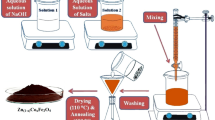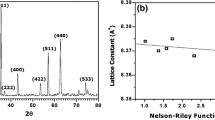Summary
Electrical conductivity properties of high-purity zinc (better than 99.9999%) have been studied at low temperatures. By analysing the resistivity ratiovs. temperature curve, it has been possible to deduce an approximate value of 175 °K for the Debye temperature of zinc. From the data deduced by the study of thickness effect on electron scattering a number of electricity carriers of 0.25±0.05 electrons/atom and a mean free path of about 100 µm, in the purest samples have been determined. A nonlinear dependence of resistivity in liquid He from the atomic concentration has been observed for some impurities, such as Pb, Cd and Cu. Finally, from the comparison of experimental data with the Seeger-Schottky theory on the electrical resistivity due to grain boundaries, a value of 4·10−12 ohm cm for unit grain-boundary surface per unit volume has been determined, and it has been possible to establish that the density decrease at grain boundaries in zinc is higher than in f.c.c. metals.
Riassunto
È stata studiata la conducibilità elettrica a bassa temperatura nello zinco di elevata purezza (superiore a 99.9999%). Dall’analisi del rapporto di resistività in funzione della temperatura, è stato possibile dedurre un valore approssimato della temperatura di Debye di 175 °K. Dai dati ricavati studiando l’effetto dello spessore sullo « scattering » degli elettroni di conduzione è stato determinato un numero di portatori di elettricità di 0.25±0.05 elettroni/atomo ed un valore del libero cammino medio di ∼ 100 µm, per il metallo di maggiore purezza. Per alcuni tipi di impurità, quali Pb, Cd, Cu è stata osservata una dipendenza non lineare della resistività in He liquido in funzione della concentrazioue. Infine, dal confronto dei dati sperimentali con la teoria di Seeger-Schottky, relativa al contributo alla resistività elettrica dovuto ai contorni intercristallini, è stato determinato un valore di 4·10−12 ohm cm per unità di superficie del contorno per unità di volume ed è stato possibile stabilire che la diminuzione di densità ai contorni intercristallini nello zinco è maggiore che nei metalli cubici a facce centrate.
Similar content being viewed by others
References
E. I. Salkovitz andA. I. Schindler:Phys. Rev.,91, 234 (1953);98, 543, 1553 (1955).
A. N. Gerritsen:Handbuch der Physik, vol.19 (Berlin, 1956), p. 161.
A. H. Wilson:The Theory of Metals (Cambridge, 1958), p. 217,
H. Jones:Handbuch der Physik, vol.19 (Berlin, 1956), p. 261.
A. Desalvo, P. Gondi, F. A. Levi andF. Zignani:Metall. Ital.,55, 551 (1963).
D. K. MacDonald:Handbuch der Physik, vol.14 (Berlin, 1956), p. 170.
See ref. (2), p. 164.
W. H. Keesom andJ. N. van den Ende:Proc. Akad. Amsterdam,35, 143 (1932).
J. M. Ziman:Electrons and Phonons (Oxford, 1960), p. 451.
See ref. (6), p. 183.
E. R. Andrew:Proc. Phys. Soc., A62, 77 (1949).
E. H. Sondheimer:Adv. in Phys.,1, 1 (1952).
K. Fuchs:Proc. Camb. Phil. Soc.,34, 100 (1938).
N. F. Mott:Proc. Camb. Phil. Soc.,32, 281 (1936).
P. de Faget de Casteljau andJ. Friedel:Journ. Phys. Rad.,17, 27 (1956);J. Friedel:Ann. de Phys.,9, 158 (1954).
F. J. Blatt:Phys. Rev.,108, 285 (1957).
P. Laurent, J. Valeur andS. Bogroff:Les bases de la résistance mécanique des métaux et des alliages (Paris, 1947), p. 279.
A. Taylor: X-Ray Metallography (New York, 1961), p. 651.
A. Seeger andG. Schottky:Acta Met.,7, 495 (1959).
H. U. Åstrom:Ark. Fys.,13, 69 (1958).
Y. Muto, Y. Tawara, Y. Shibuya andT. Fukuroi:Journ. Phys. Soc. Japan,14, 380 (1959);Y. Muto:Journ. Phys. Soc. Japan,15, 2119 (1960).
B. N. Aleksandrov:Sov. Phys. JETP,16, 399 (1963).
B. N. Aleksandrov:Phys. Metals Metallogr.,14, 3, 96 (1962).
C. G. Grenier, J. M. Reynolds andN. H. Zebourni:Phys. Rev.,129, 1088 (1963).
Author information
Authors and Affiliations
Rights and permissions
About this article
Cite this article
Desalvo, A., Gondi, P., Levi, F.A. et al. Electrical conductivity of high-purity zinc. Nuovo Cim 31, 904–913 (1964). https://doi.org/10.1007/BF02733804
Received:
Published:
Issue Date:
DOI: https://doi.org/10.1007/BF02733804




